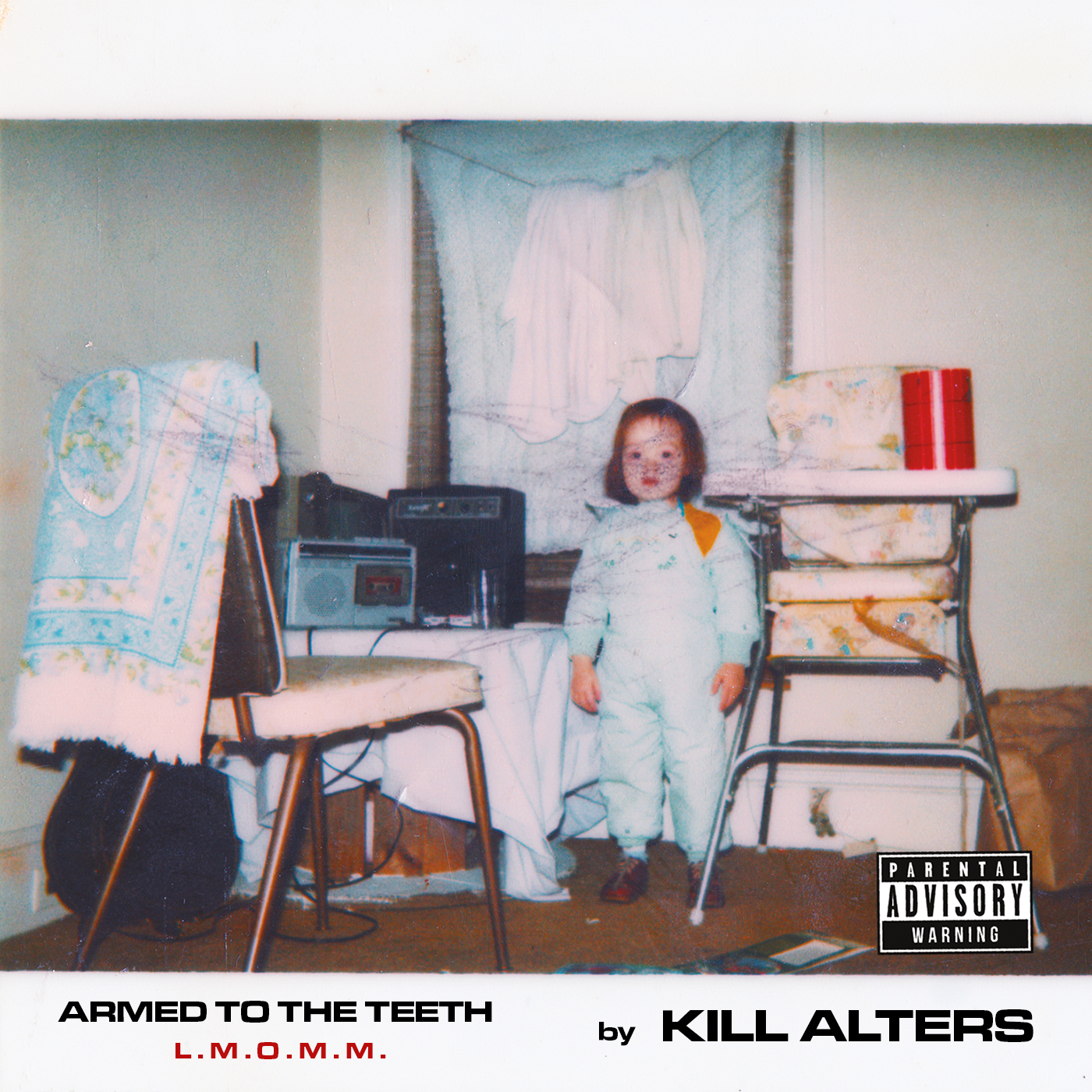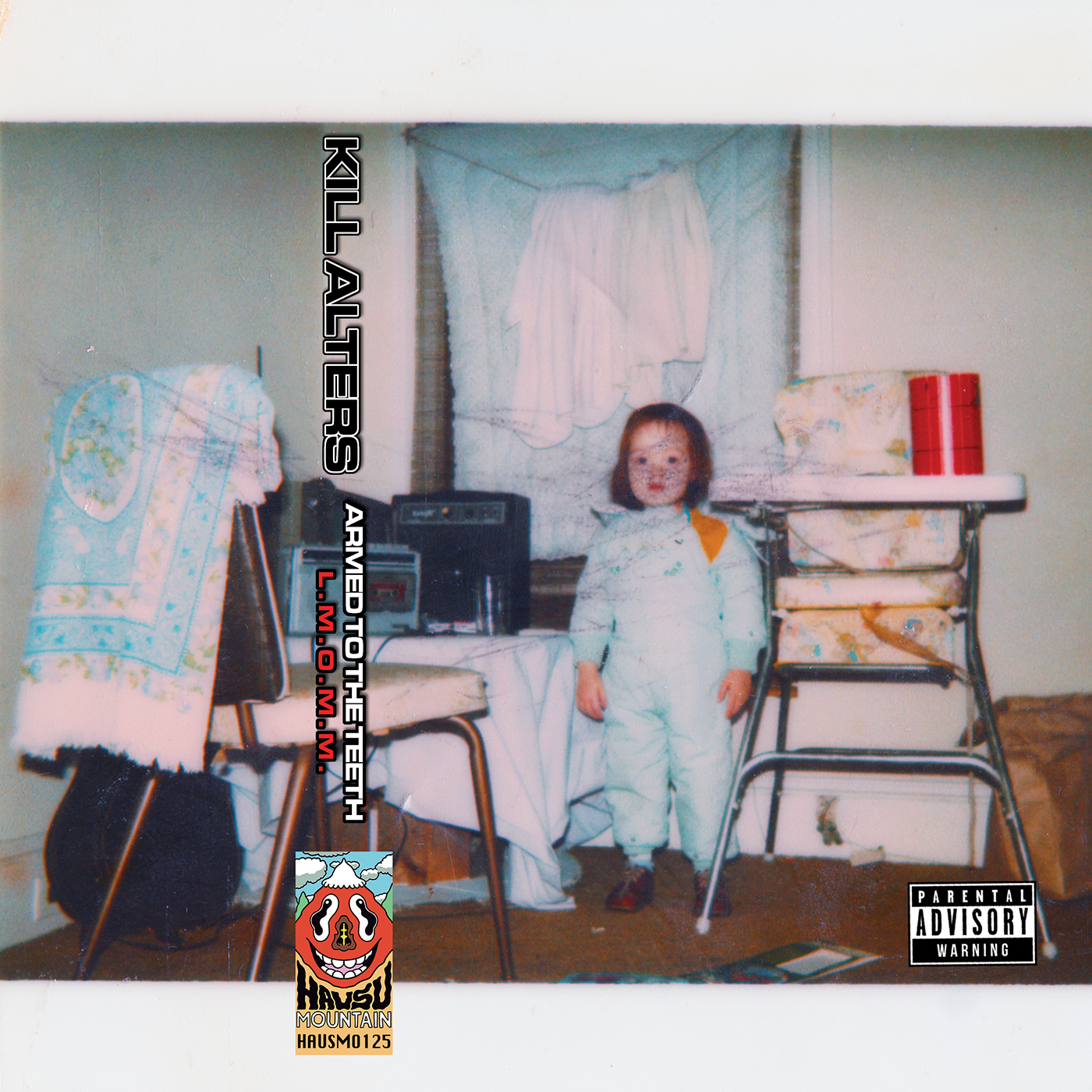
To be released on CD, cassette, and digitally on 2/11/22. Black tape with full color labels. CD packaged in a mini-LP jacket. This is the catalog page with album information and artwork. To purchase, head to our Bandcamp page.
NYC-based trio Kill Alters returns to Hausu Mountain with Armed To The Teeth L.M.O.M.M., their first full-length album following EPs and tapes including No Self Helps (HAUSMO61, 2017) and Kill Alters (2015). Taking up residence at the intersection of electronics-infused rock, digital hardcore, freewheeling mutant noise experimentation, and incidental found sound culled from bandleader and composer Bonnie Baxter’s decades-old family recordings, the album presents the band’s most intricate and mind-shattering music to date. As in all of their releases, the incorporation of Baxter’s mother’s voice from the tapes in her personal archives serves as a central element of Kill Alters‘ compositions, imbuing their music with added layers of personality and emotional memory and weaving together a story of early childhood nostalgia laced with catharsis and redemption.
Primary composer and producer Bonnie Baxter leads the band with her impassioned vocal performances, pummeling drum machine beats, and peals of chaotic synthesis. In addition to Kill Alters, Baxter’s releases in the Hausu Mountain catalog include the solo albums AXIS (HAUSMO95, 2019) and Ask Me How Satan Started (HAUSMO82, 2018). With Machine Girl mastermind Matt Stephenson, she forms the duo Prolaps, whose output includes Pure Mud: Volume 7 (HAUSMO105, 2020) and the massive four-volume, eight-hour Ultra Cycle series (HAUSMO116-119, 2021). In Kill Alters, Nicos Kennedy serves as the project’s co-producer/mixer, sound engineer, and synthesist, both shaping their sound in the context of performance and rendering their final recorded output in all its overloaded detail. Hisham Bharoocha (formerly of seminal US underground projects Black Dice and Lightning Bolt, a collaborator within the extended Boredoms universe, and a solo artist under the Soft Circle moniker) provides his signature battering ram drum performances, which collide with electronic percussion elements to animate the band’s ballistic compositions both on record and in the context of their live shows.
While Armed To The Teeth L.M.O.M.M. surges with moments of all-consuming textural disfiguration and overlapped beat architectures, Kill Alters encapsulates the sum total of their clamor into song structures that resemble something like mutated pop or rock music. Baxter’s vocal performances veer on a dime between sing-song melodies, blistering shouts, and tumbling rhythmic cadences in the spirit of hip-hop. Her fine-tuned sense of drama and narrative development as a vocalist, lyricist, and beat sculptor / synthesist funnel into fast-evolving tracks that leap into earworm hooks and unpredictable structural upheavals. Kennedy’s mixing sculpts each sonic element as a bone-thick blast within the band’s dense spreads of sound, creating tracks teeming with surprising details that evoke everything from electronic body music, to primal rock ’n’ roll, to pure abstracted texture. As the beating heart of the band, Hisham Bharoocha’s drum work flits between busy snare runs and bruising tom fills, escalating in climactic moments to the level of flesh-and-blood performances that could be mistaken for full-on drum and bass workouts.
Baxter and Kennedy started the Kill Alters project as an outlet to recontexualize the audio from an archive of home-recorded tapes made by Baxter’s mother, which date from the 1970s through the 1990s. In the context of Armed To The Teeth L.M.O.M.M., Baxter’s mother’s recordings and the environmental audio of Baxter’s childhood surroundings include personal comedic skits, overdubbed radio programs, family get-togethers, and psychological outbursts / tantrums / tics / episodes, casting Baxter’s mother as a central presence in the album’s final presentation. Described by the artists as snapshots of “a single young mother raising children in a poverty-stricken environment,” these recordings unearth emotions and themes including what Baxter calls “the negative aspect of nostalgia, and how we comfort ourselves with it to take us back to that imprisoned past within the false safety of memories.” Empathy and optimism shine through in Baxter’s and Kennedy’s hindsight viewpoint of these recordings, however, as their actual manifestation proves to be full of moments of humor and levity, harnessing Baxter’s mother’s more intense episodes as additional fuel to power the band’s overwhelming mosaics. The care and the vulnerability with which Kill Alters infuses their music with these archival recordings recasts the trauma and confusion documented within them as a source from which to draw power and achieve a new sense of clarity.


